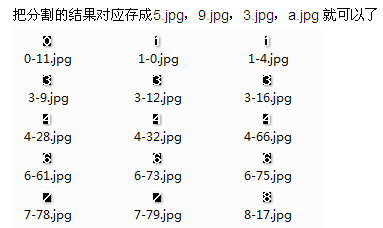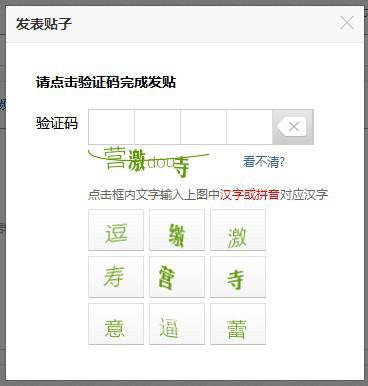铁路官方购票网站12306又出新招,在登录界面推出了全新的验证方式,用户在填写好登录名和密码之后,还要准确的选取图片验证码才能登陆成功。据悉,12306验证码改版后,目前所有抢票工具都已经无法登录。
2015年3月16日,铁路官方购票网站12306又出新招,在登录界面推出了全新的验证方式,用户在填写好登录名和密码之后,还要准确的选取图片验证码才能登陆成功。据悉,12306验证码改版后,目前所有抢票工具都已经无法登录。
多么惨绝人寰的消息,小编相信各大互联网公司都在潜心钻研新的抢票助手,来破解全新的验证码模式。
下面小编带大家看看各种验证码的设计原理及其破解方法。
首先是纯文本式验证码,是比较原始的一种。
这种验证码并不符合验证码的定义,因为只有自动生成的问题才能用做验证码,这种文字验证码都是从题库里选择出来的,数量有限。破解方式也很简单,多 刷新几次,建立题库和对应的答案,用正则从网页里抓取问题,寻找匹配的答案后破解。也有些用随机生成的数学公式,比如 随机数 [+-*/]随机运算符 随机数=?,小学生水平的程序员也可以搞定……
这种验证码也不是一无是处,对于很多见到表单就来一发的spam bot来说,实在没必要单独为了一个网站下那么大功夫。对于铁了心要在你的网站大量灌水的人,这种验证码和没有一样。
第二个是目前比较主流的图片验证码:
这类图片验证码的原理就是通过字符的粘连增加及其识别的难度,而上边这种一般用于不大的网站。
这类验证码处理方式:
图片预处理
怎么去掉背景干扰呢?可以注意到每个验证码数字或字母都是同一颜色,所以把验证码平均分成5份
计算每个区域的颜色分布,除了白色之外,颜色值最多的就是验证码的颜色,因此很容易将背景去掉
代码:
1.public static BufferedImage removeBackgroud(String picFile) 2. throws Exception { 3. BufferedImage img = ImageIO.read(new File(picFile)); 4. img = img.getSubimage(1, 1, img.getWidth() - 2, img.getHeight() - 2); 5. int width = img.getWidth(); 6. int height = img.getHeight(); 7. double subWidth = (double) width / 5.0; 8. for (int i = 0; i < 5; i++) { 9. Map<Integer, Integer> map = new HashMap<Integer, Integer>(); 10. for (int x = (int) (1 + i * subWidth); x < (i + 1) * subWidth 11. && x < width - 1; ++x) { 12. for (int y = 0; y < height; ++y) { 13. if (isWhite(img.getRGB(x, y)) == 1) 14. continue; 15. if (map.containsKey(img.getRGB(x, y))) { 16. map.put(img.getRGB(x, y), map.get(img.getRGB(x, y)) + 1); 17. } else { 18. map.put(img.getRGB(x, y), 1); 19. } 20. } 21. } 22. int max = 0; 23. int colorMax = 0; 24. for (Integer color : map.keySet()) { 25. if (max < map.get(color)) { 26. max = map.get(color); 27. colorMax = color; 28. } 29. } 30. for (int x = (int) (1 + i * subWidth); x < (i + 1) * subWidth 31. && x < width - 1; ++x) { 32. for (int y = 0; y < height; ++y) { 33. if (img.getRGB(x, y) != colorMax) { 34. img.setRGB(x, y, Color.WHITE.getRGB()); 35. } else { 36. img.setRGB(x, y, Color.BLACK.getRGB()); 37. } 38. } 39. } 40. } 41. return img; 得到与下图
接着是对图片进行纵向扫描进行切割。
再对每一部分横向扫描
然后进行训练
最后因为固定大小,识别跟 验证码识别--1 里面一样,像素比较就可以了。
源码:
1.public class ImagePreProcess2 { 2. 3. private static Map<BufferedImage, String> trainMap = null; 4. private static int index = 0; 5. 6. public static int isBlack(int colorInt) { 7. Color color = new Color(colorInt); 8. if (color.getRed() + color.getGreen() + color.getBlue() <= 100) { 9. return 1; 10. } 11. return 0; 12. } 13. 14. public static int isWhite(int colorInt) { 15. Color color = new Color(colorInt); 16. if (color.getRed() + color.getGreen() + color.getBlue() > 100) { 17. return 1; 18. } 19. return 0; 20. } 21. 22. public static BufferedImage removeBackgroud(String picFile) 23. throws Exception { 24. BufferedImage img = ImageIO.read(new File(picFile)); 25. return img; 26. } 27. 28. public static BufferedImage removeBlank(BufferedImage img) throws Exception { 29. int width = img.getWidth(); 30. int height = img.getHeight(); 31. int start = 0; 32. int end = 0; 33. Label1: for (int y = 0; y < height; ++y) { 34. int count = 0; 35. for (int x = 0; x < width; ++x) { 36. if (isWhite(img.getRGB(x, y)) == 1) { 37. count++; 38. } 39. if (count >= 1) { 40. start = y; 41. break Label1; 42. } 43. } 44. } 45. Label2: for (int y = height - 1; y >= 0; --y) { 46. int count = 0; 47. for (int x = 0; x < width; ++x) { 48. if (isWhite(img.getRGB(x, y)) == 1) { 49. count++; 50. } 51. if (count >= 1) { 52. end = y; 53. break Label2; 54. } 55. } 56. } 57. return img.getSubimage(0, start, width, end - start + 1); 58. } 59. 60. public static List<BufferedImage> splitImage(BufferedImage img) 61. throws Exception { 62. List<BufferedImage> subImgs = new ArrayList<BufferedImage>(); 63. int width = img.getWidth(); 64. int height = img.getHeight(); 65. List<Integer> weightlist = new ArrayList<Integer>(); 66. for (int x = 0; x < width; ++x) { 67. int count = 0; 68. for (int y = 0; y < height; ++y) { 69. if (isWhite(img.getRGB(x, y)) == 1) { 70. count++; 71. } 72. } 73. weightlist.add(count); 74. } 75. for (int i = 0; i < weightlist.size();) { 76. int length = 0; 77. while (weightlist.get(i++) > 1) { 78. length++; 79. } 80. if (length > 12) { 81. subImgs.add(removeBlank(img.getSubimage(i - length - 1, 0, 82. length / 2, height))); 83. subImgs.add(removeBlank(img.getSubimage(i - length / 2 - 1, 0, 84. length / 2, height))); 85. } else if (length > 3) { 86. subImgs.add(removeBlank(img.getSubimage(i - length - 1, 0, 87. length, height))); 88. } 89. } 90. return subImgs; 91. } 92. 93. public static Map<BufferedImage, String> loadTrainData() throws Exception { 94. if (trainMap == null) { 95. Map<BufferedImage, String> map = new HashMap<BufferedImage, String>(); 96. File dir = new File("train2"); 97. File[] files = dir.listFiles(); 98. for (File file : files) { 99. map.put(ImageIO.read(file), file.getName().charAt(0) + ""); 100. } 101. trainMap = map; 102. } 103. return trainMap; 104. } 105. 106. public static String getSingleCharOcr(BufferedImage img, 107. Map<BufferedImage, String> map) { 108. String result = ""; 109. int width = img.getWidth(); 110. int height = img.getHeight(); 111. int min = width * height; 112. for (BufferedImage bi : map.keySet()) { 113. int count = 0; 114. int widthmin = width < bi.getWidth() ? width : bi.getWidth(); 115. int heightmin = height < bi.getHeight() ? height : bi.getHeight(); 116. Label1: for (int x = 0; x < widthmin; ++x) { 117. for (int y = 0; y < heightmin; ++y) { 118. if (isWhite(img.getRGB(x, y)) != isWhite(bi.getRGB(x, y))) { 119. count++; 120. if (count >= min) 121. break Label1; 122. } 123. } 124. } 125. if (count < min) { 126. min = count; 127. result = map.get(bi); 128. } 129. } 130. return result; 131. } 132. 133. public static String getAllOcr(String file) throws Exception { 134. BufferedImage img = removeBackgroud(file); 135. List<BufferedImage> listImg = splitImage(img); 136. Map<BufferedImage, String> map = loadTrainData(); 137. String result = ""; 138. for (BufferedImage bi : listImg) { 139. result += getSingleCharOcr(bi, map); 140. } 141. ImageIO.write(img, "JPG", new File("result2//" + result + ".jpg")); 142. return result; 143. } 144. 145. public static void downloadImage() { 146. HttpClient httpClient = new HttpClient(); 147. GetMethod getMethod = null; 148. for (int i = 0; i < 30; i++) { 149. getMethod = new GetMethod("http://www.pkland.net/img.php?key=" 150. + (2000 + i)); 151. try { 152. // 执行getMethod 153. int statusCode = httpClient.executeMethod(getMethod); 154. if (statusCode != HttpStatus.SC_OK) { 155. System.err.println("Method failed: " 156. + getMethod.getStatusLine()); 157. } 158. // 读取内容 159. String picName = "img2//" + i + ".jpg"; 160. InputStream inputStream = getMethod.getResponseBodyAsStream(); 161. OutputStream outStream = new FileOutputStream(picName); 162. IOUtils.copy(inputStream, outStream); 163. outStream.close(); 164. System.out.println(i + "OK!"); 165. } catch (Exception e) { 166. e.printStackTrace(); 167. } finally { 168. // 释放连接 169. getMethod.releaseConnection(); 170. } 171. } 172. } 173. 174. public static void trainData() throws Exception { 175. File dir = new File("temp"); 176. File[] files = dir.listFiles(); 177. for (File file : files) { 178. BufferedImage img = removeBackgroud("temp//" + file.getName()); 179. List<BufferedImage> listImg = splitImage(img); 180. if (listImg.size() == 4) { 181. for (int j = 0; j < listImg.size(); ++j) { 182. ImageIO.write(listImg.get(j), "JPG", new File("train2//" 183. + file.getName().charAt(j) + "-" + (index++) 184. + ".jpg")); 185. } 186. } 187. } 188. } 189. 190. /** 191. * @param args 192. * @throws Exception 193. */ 194. public static void main(String[] args) throws Exception { 195. // downloadImage(); 196. for (int i = 0; i < 30; ++i) { 197. String text = getAllOcr("img2//" + i + ".jpg"); 198. System.out.println(i + ".jpg = " + text); 199. } 200. } 201.}
像BAT这种巨头的验证码通过干扰线、加粗不加粗混用、采用中文常用字(中文常用字大概有5000个,笔画繁复,形似字多,比起26个字母难度高很多)、不同的字体混用,比如楷体、宋体、幼圆混用、拼音,扭曲字体、需要准确识别13位汉字,大大增加了失败概率。
当然除了主流的图片验证码外,一些网站为了照顾视力不好的用户,采用语音验证码。一般这种验证码是机器生成一段读数字的语音。但是在这方面上很多程序员都偷懒了,预先找了10个数字的声音录音,然后生成的时候把他们随机拼到一起,结果就是这样:
设计原理如下:
整体效果
•字符数量一定范围内随机
•字体大小一定范围内随机
•波浪扭曲(角度方向一定范围内随机)
•防识别
•不要过度依赖防识别技术
•不要使用过多字符集-用户体验差
•防分割 •
重叠粘连比干扰线效果好
•备用计划
•同样强度完全不同的一套验证码
既然原理都已经知道了,那么如何破解就变得简单了。
但是问题来了,这次12306的验证码居然是图片,以上方式都不能使用,那么就不能破解了么?
有人认为12306的网站图片内存不会太大,完全可以扒下来,然后进行破解。当然这是纸上谈兵,有一种非常先进又非常原始的办法叫做“网络打码”或者“人肉打码”
一些技术大牛把验证码发送的自制的“打码”软件上,而一些“打码工”通过这个程序来输入机器自动注册,出来的验证码,传输到自动注册机器,完成验证。
目前来看这种简单粗暴的方法可以应对目前的情况。
结语:
12306这次可谓出了杀招,把所有抢票软件一刀砍死,黄牛们不开心我们就可以买到票了。既解决了黄牛问题又为广大程序员出了一道难题。





























 667
667











 被折叠的 条评论
为什么被折叠?
被折叠的 条评论
为什么被折叠?








